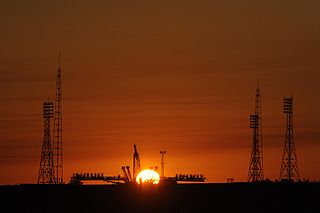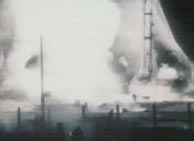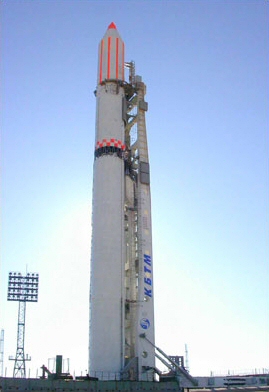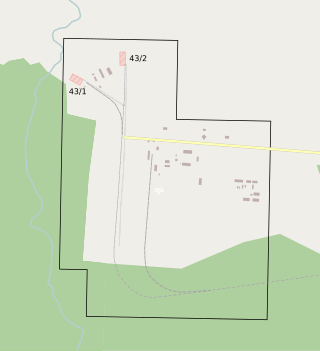
A hybrid-propellant rocket is a rocket with a rocket motor that uses rocket propellants in two different phases: one solid and the other either gas or liquid. The hybrid rocket concept can be traced back to the early 1930s.

A hypergolic propellant is a rocket propellant combination used in a rocket engine, whose components spontaneously ignite when they come into contact with each other.

Soyuz is a family of expendable Russian and Soviet carrier rockets developed by OKB-1 and manufactured by Progress Rocket Space Centre in Samara, Russia. The Soyuz is the rocket with the most launches in the history of spaceflight.

The R-7 Semyorka, officially the GRAU index 8K71, was a Soviet missile developed during the Cold War, and the world's first intercontinental ballistic missile. The R-7 made 28 launches between 1957 and 1961. A derivative, the R-7A, was operational from 1960 to 1968. To the West it was unknown until its launch. In modified form, it launched Sputnik 1, the first artificial satellite, into orbit, and became the basis for the R-7 family which includes Sputnik, Luna, Molniya, Vostok, and Voskhod space launchers, as well as later Soyuz variants. Various modifications are still in use and it has become the world’s most reliable space launcher.

The Baikonur Cosmodrome is a spaceport operated by Russia within Kazakhstan. Located in the Kazakh city of Baikonur, it is the largest operational space launch facility in terms of area. All Russian crewed spaceflights are launched from Baikonur.

Plesetsk Cosmodrome is a Russian spaceport located in Mirny, Arkhangelsk Oblast, about 800 km north of Moscow and approximately 200 km south of Arkhangelsk. As of 2024, it is Europe's only operational orbital spaceport and the northernmost spaceport in the world. Originally developed as an ICBM site for the R-7 missile, it also served for numerous satellite launches using the R-7 and other rockets. Its high latitude makes it useful only for certain types of launches, especially the Molniya orbits, so for much of the site's history it functioned as a secondary location, with most orbital launches taking place from Baikonur, in the Kazakh SSR. With the end of the Soviet Union, Baikonur became a foreign territory, and Kazakhstan charged $115 million usage fees annually. Consequently, Plesetsk has seen considerably more activity since the 2000s.

The Nedelin catastrophe or Nedelin disaster, known in Russia as the Catastrophe at Baikonur Cosmodrome, was a launch pad accident that occurred on 24 October 1960 at the Baikonur Cosmodrome in Soviet Kazakhstan. As a prototype of the R-16 intercontinental ballistic missile was being prepared for a test flight, an explosion occurred when the second stage engine ignited accidentally, killing an unknown number of military and technical personnel working on the preparations. Despite the magnitude of the disaster, information was suppressed for many years and the Soviet government did not acknowledge the event until 1989. With more than 54 casualties, it is the deadliest disaster in space exploration history. The catastrophe is named for the Chief Marshal of Artillery Mitrofan Ivanovich Nedelin, who was the head of the R-16 development program and perished in the explosion.

Vostok was a family of rockets derived from the Soviet R-7 Semyorka ICBM and was designed for the human spaceflight programme. This family of rockets launched the first artificial satellite and the first crewed spacecraft (Vostok) in human history. It was a subset of the R-7 family of rockets.
Korabl-Sputnik 3 or Vostok-1K No.3, also known as Sputnik 6 in the West, was a Soviet spacecraft which was launched in 1960. It was a test flight of the Vostok spacecraft, carrying two dogs; Pcholka and Mushka, as well as a television camera and scientific instruments.

The Angara rocket family is a family of launch vehicles being developed by the Moscow-based Khrunichev State Research and Production Space Center. The launch vehicles are to put between 3,800 kg (8,400 lb) and 24,500 kg (54,000 lb) into low Earth orbit and are intended, along with Soyuz-2 variants, to replace several existing launch vehicles.
High-test peroxide (HTP) is a highly concentrated solution of hydrogen peroxide, with the remainder consisting predominantly of water. In contact with a catalyst, it decomposes into a high-temperature mixture of steam and oxygen, with no remaining liquid water. It was used as a propellant of HTP rockets and torpedoes, and has been used for high-performance vernier engines.
The highest specific impulse chemical rockets use liquid propellants. They can consist of a single chemical or a mix of two chemicals, called bipropellants. Bipropellants can further be divided into two categories; hypergolic propellants, which ignite when the fuel and oxidizer make contact, and non-hypergolic propellants which require an ignition source.

The staged combustion cycle is a power cycle of a bipropellant rocket engine. In the staged combustion cycle, propellant flows through multiple combustion chambers, and is thus combusted in stages. The main advantage relative to other rocket engine power cycles is high fuel efficiency, measured through specific impulse, while its main disadvantage is engineering complexity.

The Meteor spacecraft are weather observation satellites launched by the Soviet Union and Russia. The Meteor satellite series was initially developed during the 1960s. The Meteor satellites were designed to monitor atmospheric and sea-surface temperatures, humidity, radiation, sea ice conditions, snow-cover, and clouds. Between 1964 and 1969, a total of eleven Soviet Union Meteor satellites were launched.

The Zenit-2 was a Ukrainian, previously Soviet, expendable carrier rocket. First flown in 1985, it has been launched 37 times, with 6 failures. It is a member of the Zenit family of rockets and was designed by the Yuzhmash.

The R-7 family of rockets is a series of rockets, derived from the Soviet R-7 Semyorka, the world's first intercontinental ballistic missile (ICBM). More R-7 rockets have been launched than any other family of large rockets.

Site 43, also known as SK-3 and SK-4, is a launch complex at the Plesetsk Cosmodrome in Russia. It consists of a two pads, Sites 43/3 and 43/4, and has been used by R-7 derived rockets since the early 1960s.
The Vostok-2, GRAU index 8A92 was an expendable carrier rocket used by the Soviet Union between 1962 and 1967. Forty five were launched, of which five failed. It was derived from the earlier Vostok-K, with uprated engines. It was a member of the Vostok family of rockets.

The Vostok-2M, GRAU index 8A92M was an expendable carrier rocket used by the Soviet Union between 1964 and 1991. Ninety-three were launched, of which one failed. Another was destroyed before launch. It was originally built as a specialised version of the earlier Vostok-2, for injecting lighter payloads into higher Sun-synchronous orbits. It was a member of the R-7 family of rockets, and the last Vostok.

Rocket propellant is the reaction mass of a rocket. This reaction mass is ejected at the highest achievable velocity from a rocket engine to produce thrust. The energy required can either come from the propellants themselves, as with a chemical rocket, or from an external source, as with ion engines.
















